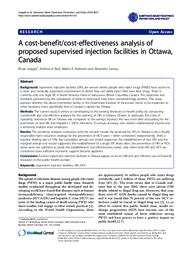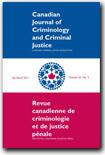Criminology
Related Works
Content type
Digital Document
Abstract
Background:
This paper will determine whether expanding Insite (North America’s first and only supervised injection facility) to more locations in Canada such as Montreal, cost less than the health care consequences of not having such expanded programs for injection drug users.
<p>Methods:
By analyzing secondary data gathered in 2012, this paper relies on mathematical models to estimate the number of new HIV and Hepatitis C (HCV) infections prevented as a result of additional SIF locations in Montreal.
<p>Results:
With very conservative estimates, it is predicted that the addition of each supervised injection facility (up-to a maximum of three) in Montreal will on average prevent 11 cases of HIV and 65 cases of HCV each year. As a result, there is a net cost saving of CDN$0.686 million (HIV) and CDN$0.8 million (HCV) for each additional supervised injection site each year. This translates into a net average benefit-cost ratio of 1.21: 1 for both HIV and HCV.
<p>Conclusions:
Funding supervised injection facilities in Montreal appears to be an efficient and effective use of financial resources in the public health domain.
Origin Information
Content type
Digital Document
Abstract
Background: Supervised injection facilities (SIFs) are venues where people who inject drugs (PWID) have access to a clean and medically supervised environment in which they can safely inject their own illicit drugs. There is currently only one legal SIF in North America: Insite in Vancouver, British Columbia, Canada. The responses and feedback generated by the evaluations of Insite in Vancouver have been overwhelmingly positive. This study assesses whether the above mentioned facility in the Downtown Eastside of Vancouver needs to be expanded to other locations, more specifically that of Canada’s capital city, Ottawa.
<p>Methods: The current study is aimed at contributing to the existing literature on health policy by conducting cost-benefit and cost-effective analyses for the opening of SIFs in Ottawa, Ontario. In particular, the costs of operating numerous SIFs in Ottawa was compared to the savings incurred; this was done after accounting for the prevention of new HIV and Hepatitis C (HCV) infections. To ensure accuracy, two distinct mathematical models and a sensitivity analysis were employed.
<p>Results: The sensitivity analyses conducted with the models reveals the potential for SIFs in Ottawa to be a fiscally responsible harm reduction strategy for the prevention of HCV cases – when considered independently. With a baseline sharing rate of 19%, the cumulative annual cost model supported the establishment of two SIFs and the marginal annual cost model supported the establishment of a single SIF. More often, the prevention of HIV or HCV alone were not sufficient to justify the establishment cost-effectiveness; rather, only when both HIV and HCV are considered does sufficient economic support became apparent.
<p>Conclusions: Funded supervised injection facilities in Ottawa appear to be an efficient and effective use of financial resources in the public health domain.
Origin Information
Content type
Digital Document
Abstract
This study was conducted not only to explore how peers intervene to shape social networks but to capture the transformative role of peer-led intervention by local needle exchange programs and a supervised injection facility in Vancouver, Canada. Semi-structured qualitative interviews were conducted with peer volunteers as they were involved in their routine work activities. Interviews were analysed thematically using two methods of coding analysis. Findings suggest that peers were taking on important education and safety roles and were able to alter the behaviour, attitude, and intention of injection drug users within the Downtown Eastside area of the city. Further, peer injection drug users were able to reach individuals who were reluctant to seek medical help, housing, or prevention services. Peers serve as an agent of change in the Downtown Eastside to disseminate information and riskreduction skills to the most marginalized people.
Origin Information
Content type
Digital Document
Abstract
Performance measures depend on the clarity and consistency of their metrics. The standard unit of analysis of court proceedings is the “case.” Yet the definition of a case varies widely. It may include multiple accused persons and charges, a count of accused persons, the number of informations (a set of charges), or the number of charges. Likewise, whether new cases, completed cases, or the number of cases heard in court are counted make a tremendous difference. In theory, many dozens of caseload measures are possible. Here, a matrix of twelve measures is proposed which balances theoretical exhaustion with practicality. Using data for one year of adult criminal cases in the Provincial Court of British Columbia it is shown that the choice of measure introduces variability of workload over 400 per cent. The matrix is intended as a heuristic device for policy-makers to scrutinise case-based indicators.
Origin Information
Content type
Digital Document
Abstract
A non-monitored closed-circuit television (CCTV) pilot project commenced at the Scott Road Skytrain Station Park and Ride in Surrey, BC in August 2009. The pilot project was implemented by the City of Surrey and scheduled for 1 year. This article reports on an evaluation of the CCTV system with respect to its ability to reduce vehicle-related crime at the pilot site. Using police and insurance data, the evaluation considers the trends of vehicle-related crimes over several years in the City of Surrey and the northern district of the Corporation of Delta, BC. In general, there is little evidence of a significant drop in vehicle-related crime that can be attributed to the CCTV system. Moreover, we show that the results are dependent on the methods used for evaluation; this is critical because we show that a more commonly used method (that we consider inappropriate) indicates a significant drop in vehicle-related crime.
Origin Information
Content type
Digital Document
Abstract
In predicting treatment compliance in individuals with severe mental illness, research has focused on variables such as substance abuse, personality, history of child abuse, and symptomatology, although these relationships have not been investigated in great detail in individuals at the onset of mental illness. To better understand these correlates of treatment compliance, two samples were examined: a sample of 117 individuals presenting with a first episode of psychosis and a more chronic forensic sample of 65 participants recruited from a psychiatric hospital. These samples were investigated for service engagement in terms of violence history, substance abuse, symptom severity, psychopathic traits and history of childhood abuse. Linear regressions performed for the first episode sample revealed that childhood physical abuse was the strongest predictor of poor service engagement, followed by problems with alcohol, a history of physical violence, any history of violence and higher psychopathic traits. Linear regression revealed for the forensic group that a lower level of service engagement was most strongly predicted by a history of childhood abuse and a higher score on the Brief Psychiatric Rating Scale (BPRS). Results are presented in light of the existing literature and clinical implications are discussed.
Origin Information
Content type
Digital Document
Abstract
This study explores the impact of adjudicated residential addiction treatment on recidivism in female youth. Recidivism was measured both in elapsed time to reoffending and in number of new offences in several offence categories. Findings indicate that female youth admitted to the residential addiction treatment program demonstrated reduced recidivism in several offence categories, compared to youth who were referred, but not admitted, to the program. Unlike previous research, this study did not indicate a relationship between multiproblem youth and reduced engagement and retention or less positive treatment outcomes. As the treatment program operates as an alternative to custody, these findings support that adjudicated treatment may be effective in addressing the issues underlying criminal behaviour in some youth.
Origin Information
Content type
Digital Document
Abstract
Canadian legislation surrounding sentencing has been prefaced by a statement of the purposes and principles of sentencing since 1996. This legislation identifies proportionality as the fundamental principle in sentencing, and states that sentences should be proportional to the gravity of the offence and the degree of responsibility of the offender. Although prior criminal record may be considered as an aggravating factor by the judiciary when deciding upon an appropriate sentence, our current legislation does not mirror other sentencing systems such as those seen in the United States, where a criminal record may at times form the sole basis for the increasing length of incarceration. The Canadian experience with the sentencing of chronic offenders is an important indicator of sentencing policy in practice. If proportionality is the primary goal of sentencing, how are Canadian judges handling those chronic property offenders who commit dozens or even hundreds of offences over their criminal history? Are sentences strictly controlled by the gravity of the instant offence or are they being inflated by the offender’s criminal history? The aim of this study is to examine if indicators of sentence inflation can be observed in the sentencing patterns for one such group of chronic offenders. In general, the results appear mixed, as some increasing severity outside of the nature of the offence can be seen in terms of denial of bail and imposition of a custodial sentence. However, analysis of the length of the custodial sentences does not clearly demonstrate substantial inflation over those that would be expected solely on the basis of proportionality even for the most incorrigible offenders. What this creates, however, is a revolving door for many of these offenders. The difficulty comes with trying to balance the needs of the public in terms of protection from such chronic offenders (Street Crime Working Group, 2005), while still adhering to the legislated purposes and principles of sentencing.
Origin Information
Content type
Digital Document
Abstract
Concerns over rising costs have forced police services to balance increasing fiscal and operational pressures. Discussions of the resources and requirements of police, however, are generally only informed by political expediency and traditional practice. Operational reviews (ORs) can be used to document the demands on police, their capacity to respond, and ways in which they can become more efficient and effective. Drawing on an OR of a major urban Canadian police service, this article provides a broad outline of the components of an OR and the analytics that can be used to answer these key questions.
Origin Information
Content type
Digital Document
Abstract
Television crime dramas such as “CSI: Miami“, “NYPD Blue”, and “Law and Order” have glamourized the careers of criminal justice personnel by shaping their job descriptions into ones which are exciting, highly eventful, and immediately rewarding. In addition, television advertisements from American career technical schools in the United States often inaccurately portray their students in criminology programs. The purpose of this study was to examine the relationship between the amount of media consumed and subjects' perceptions of the study of criminology. Data were collected through an anonymous pencil and paper survey. Participants were randomly selected from 100-level criminology classes at the University College of the Fraser Valley (n=131). Results suggest that television and radio consumption are significantly related to inaccurate perceptions of the study of criminology. No other forms of media are shown to be related. Recommendations for future research include a focus on marketing criminology programs and studies examining students of all ages. The implications for post-secondary criminology programs are discussed.
Origin Information








